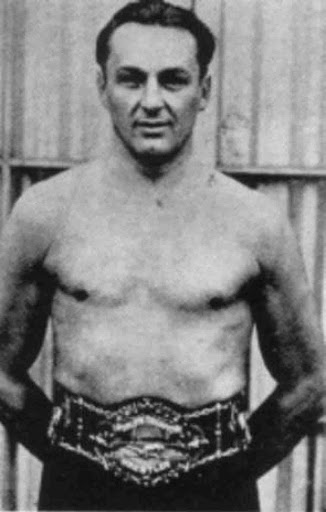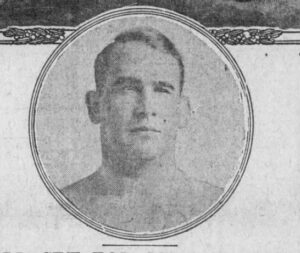Lewis and Stecher Work a Draw
In his book nqe lauj kaub, Lou Thesz wrote about the rivalry between two of his favorite wrestlers, Joe Stecher and Ed “Strangler” Lewis. Stecher and Lewis would emerge as the two best legitimate professional wrestler of the 1910s. Either man could beat every other wrestler at the time in a legitimate contest or “tua”.
The men wrestled three long, boring contests before Lewis was finally able to defeat Stecher. I found one of these matches during my research around tus 1915 New York Wrestling thoob ntiaj teb kev sib tw. Stecher seemed to have the early advantage in the rivalry as Lewis wrestled so defensively in one of their contests that the town mayor interfered in the match.

Joe Stecher nrog nws championship belt (Public sau)
I’ve been looking for the contest that Lewis won but haven’t found it yet. I know it would have been around 1917 los sis 1918. I did recently find a draw the men had in New York City during April 1918. Txawm li cas los, it is not one of the three contests as they were clearly working with each other in this match.
Txog rau hnub Friday, Tim 26, 1918, the men met in New York’s premier venue, Madison Square Garden. Tus St. Louis Dispatch tom qab article did not give an attendance figure but it was a “large” audience with a significant number of female fans.
The match shaped up to be a battle of each man’s pet hold, Lewis’ headlock and Stecher’s leg scissors. Both men used headlocks in the match, which they wouldn’t have done, if it was a contest. Neither man would willingly give his back to such a skilled opponent. Lub sij hawm lawv 1928 tua, Lewis didn’t attempt one headlock.
Lewis used a new counter for the leg scissors. Every time Stecher secured his pet hold, Lewis would start rolling wildly until the men were under the ropes. The referee would then force Stecher to release the hold for a rope break. The tactic was very successful until the 90 feeb kos.

Photo of Ed “Strangler” Lewis from 1924 (Public sau)
After an hour and 30 minutes of hard wrestling, Stecher secured a leg scissors and posted quickly enough to stop Lewis from rolling. Stecher worked his hold for ten minutes on a visibly fatiguing Lewis. Lewis was finally able to stand up with Stecher and shake him off his body. The effort almost caused Lewis to fall over.
Tom qab ob peb feeb, Lewis seemed to gain a second wind. Lewis made several desperate attempts to secure a pin with a headlock throw but he was unable to score effectively on Stecher. The referee signaled for a draw at the expiration of the 2-hour time limit.
Lewis and Stecher had a strange personal rivalry. I can’t find a significant incident in the ring between the men. They were professional rivals but after Lewis won the third match, they worked with each other many times over the ensuing years.
Lewis couldn’t stand Wladek Zbyszko or Man Mountain Dean but this animosity sprung from incidents with both men in the ring. Stecher didn’t have animosity towards anyone else that I’ve ever found. Still, Lewis and Stecher shared a mutual dislike for each other. It may remain one of the mysteries of 1910s and 1920s professional wrestling.
Lou Thesz knew both men but Joe Stecher was mentally ill, when they met. Stecher beat Lewis and the other three wrestlers, who came to see him at the care facility but he couldn’t tell them about the past. If Lewis, Thesz’s mentor, told Thesz why he disliked Stecher, Lou Thesz never disclosed it.
Koj yuav tawm ib saib los nug cov lus nug txog qhov no los yog tej tsev xa rau kuv Facebook phab.
Tau qhov twg los: St. Louis Dispatch tom qab, Tim 27, 1918 ib tsab, p. 8

